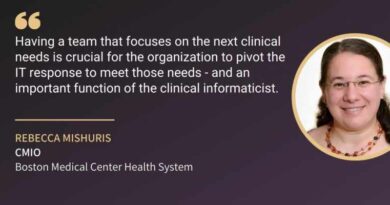The Wonderful World of Post M&A in Healthcare
By Lynn Gibson, CTO/VP, CHRISTUS Health
There seem to be two very different worlds in the pre and post-merger worlds that an organization goes through. It is the pre-merger discussion and the post-merger discussion. In the pre-merger, there will likely be some shared services leaders involved, but many will be there following the direction of the senior executive team to be sure the deal gets signed. Once signing day comes and goes, then reality begins to set in.
Dependent upon your industry, there may be some processes and workflows to manage, but the bigger issue for the first year or two will be your shared services that will quickly need to be the focus. Human Resources, Supply Chain, Finance, Information Technology, and Revenue Cycle will become top of mind. The information technology (IT) division will be a crucial part in making the other areas successful. The IT department will need to pay close attention to six critical elements as the merger begins to take form.
The goals and strategy of the merger will determine the decision on what the primary tools will be and how they will be housed can become a technical, operational and perhaps a political issue. Governance can be a challenge depending upon the goals and strategies adopted by the operational teams. What policies will become the primary for the combined organization? The decision to expend capital and what defines capital will have a strong influence on budget and time to production. `One organization may capitalize laptops and another expend them. If the agreement contains a partnership reference, it may require any changes to the budget or capital expense be approved by a separate board. If there is a governance committee, a decision as to its composition will need to be determined and this can lead to political challenges. A close parallel to operational committees or even Board committees would be the prudent model to follow.
The nature of the vendor agreements and licensing of the tools will need to be studied and the vendor providing the major applications tools will need to be approached to gather all the requirements from both an operational and a technical view. It should never be assumed that what is in place with the dominant member of the merger is what should be the final solution. Consider this situation: Company A is the dominant member of the merger and its electronic health record is on application X. Company B is the junior member of the merger and uses application Y for the electronic medical record. Application X is an older product and the vendor has a new architected application which Company A has considered. Application Y is a popular application which also has been considered by Company A but has been hesitant to make the conversion because of cost and impact on the organization. The merger may provide the right time to make the commitment to either upgrade the application X or replace it with application Y. A strong analysis without assumptions will be necessary and would be the same even if it is a direct acquisition.
The goals and strategy of the merger will determine the decision on what the primary tools will be and how they will be housed can become a technical, operational and perhaps a political issue.
The status of the infrastructure of each part of the organization will need to be evaluated and then a strategy established that matches the overall goals of the merger. If the goal is to minimize utilization of capital, then perhaps the use of cloud services would help optimize the strategy and provide new infrastructure to the new organization. If minimizing operational cost is a goal, then perhaps the strategy would be the preservation of the current environments and establish trusts between the different domains and applications. If the acquired organization owned a new data center with capacity, it could be the prudent decision to consolidate to the new facility and close the dominant organization’s to save operating expense.
Provisioning will be a challenge. Will systems are held in a common domain or will environments be preserved for an extended period of time. If the environments are to be in a common domain, will it be under an existing domain or will a new domain (corporate name possibly) be introduced? If existing domains will be preserved, will certain groups of associates need to have access to both? What does this mean to access to shared corporate policies, calendars, emails? The IT department will need to determine the toolsets to manage the provision of users and applications. The automation of the provisioning and onboarding process will have a direct impact on the time to market and on associate satisfaction. An organized and easy to use provisioning tool will help the change with associates and clinical teams have a feeling of success.
Too many times, the operational team will set a goal to reduce staff redundancy. In the IT world, this should be one of the last functions tackled as significant work will need to occur and maintain the existing environments while transitioning to the targeted environment whether existing or new. This will provide a great time to access the strengths and weaknesses of both teams. Try to eliminate an initial fear of loss of employment. If this issue is not addressed early, it can become a significant risk to the organization and strong security measures will be needed to mitigate the risk.
As the fifth point to consider by no means gives it a less priority than the others and it is your cyber security analysis. It would be prudent to engage a third party to perform an assessment of both organizations and provide recommendations. This could impact the infrastructure decision as well as any personnel decisions.
Each merger or acquisition will bring its own unique challenge. There can be no specific checklist that will cover every issue. The successful IT initiatives inside the goals of the mergers will need to be flexible and able to respond quickly. The successful IT leader will warn the operational leaders what can change quickly and what cannot and what will have an impact on the financials during the first year. If this can be done early, the more successful the merger will be.



